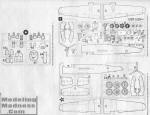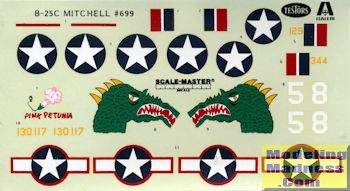
Testors/Italeri 1/72 B-25C Mitchell
| KIT #: | 699 |
| PRICE: | $6.95 SRP when new back in the mid 1980s. |
| DECALS: | Two options |
| REVIEWER: | Scott Van Aken |
| NOTES: |

| HISTORY |
The North American B-25 Mitchell was an American twin-engined medium bomber manufactured by North American Aviation. It was used by many Allied air forces, in every theater of World War II, as well as many other air forces after the war ended, and saw service across four decades.
The B-25 was named in honor of General Billy Mitchell, a pioneer of U.S. military aviation. By the end of its production, nearly 10,000 B-25s in numerous models had been built. These included a few limited variations, such as the United States Navy's and Marine Corps' PBJ-1 patrol bomber and the United States Army Air Forces' F-10 photo reconnaissance aircraft.
The first variant used in combat was the B-25B, though it was built in small numbers (120). The B-25C was an improved version of the B-25B: powerplants upgraded from Wright R-2600-9 radials to R-2600-13s; de-icing and anti-icing equipment added; the navigator received a sighting blister; nose armament was increased to two .50 in (12.7 mm) machine guns, one fixed and one flexible. The B-25C model was the first mass-produced B-25 version; it was also used in the United Kingdom (as the Mitchell II), in Canada, China, the Netherlands, and the Soviet Union. (Number made: 1,625.) The B-25D was identical to the B-25C, the only difference was that the B-25D was made in Kansas City, Kansas, whereas the B-25C was made in Inglewood, California. First flew on 3 January 1942. (Number made: 2,290.) Early versions of this aircraft had a collector exhaust while later variants had individual ejector exhaust.
| THE KIT |
 It is surprising that,
unless someone snuck one by me, after all these years, the Italeri kit is still
the best and in many cases only one around of the early B-25s in this scale. Monogram did a
snap kit of this variant, but it is not as nice as the Italeri kit. I would have
thought that Hasegawa would have done this version by simply coming up with new
fuselage halves and engine cowlings, but that has not happened yet.
It is surprising that,
unless someone snuck one by me, after all these years, the Italeri kit is still
the best and in many cases only one around of the early B-25s in this scale. Monogram did a
snap kit of this variant, but it is not as nice as the Italeri kit. I would have
thought that Hasegawa would have done this version by simply coming up with new
fuselage halves and engine cowlings, but that has not happened yet.  Marking are for two planes. One is the box art plane from the 405 BS/38th BG.
This group had tigers, wolves and dragons on the nose of their planes. This one
is a dragon. It is OD over neutral grey with green fin tips. The other is a
North African plane from the 83BS/12BG and is in sand over neutral grey with
chipped leading edges showing the underlying OD. My kit has two decal sheets,
but I'm not sure just how viable they may be. Fortunately, there are aftermarket
decals out there if you look.
Marking are for two planes. One is the box art plane from the 405 BS/38th BG.
This group had tigers, wolves and dragons on the nose of their planes. This one
is a dragon. It is OD over neutral grey with green fin tips. The other is a
North African plane from the 83BS/12BG and is in sand over neutral grey with
chipped leading edges showing the underlying OD. My kit has two decal sheets,
but I'm not sure just how viable they may be. Fortunately, there are aftermarket
decals out there if you look.| CONCLUSIONS |
 This kit can often be found from vendors for under $10
and is well worth the effort of building, especially if you like the Mitchell.
To the right is your editor's build from 1985.
This kit can often be found from vendors for under $10
and is well worth the effort of building, especially if you like the Mitchell.
To the right is your editor's build from 1985.
April 2015
Thanks to me for picking this one up.
If you would like your product reviewed fairly and fairly quickly, please contact the editor or see other details in the Note to Contributors.